Arhats
The
Arhats are historical personages. They were disciples of Buddha to whom Buddha
Sakyamuni. entrusted the work of promulgating and protecting the sacred
Doctrine. According to Indian tradition the Arhats are sixteen in number but in
Tibet two more companions are added to this group and are popularly known as
the 'Eighteen Arhats'. They are subject to no more rebirths and are generally
depicted with monastic garments and bare-headed with various attributes.
Arhat
Pindola Bharadvaja is seated on leaves spread over a rock. His right hand holds
the manuscript and his left hand is with an alms-bowl which according to
Tibetan tradition has the power of fulfilling the wishes. Around him there are
blossoming trees, high-peaked mountains, temples, stupas, etc. At the top
Buddha is represented in bhusparsa and vyakhyanamudra at two corners. Below
there are figures of lions with yellow manes and tails and a devotee in Chinese
dress, carrying water-jug and holding a fan. The thanka betrays Kham art
traditions with strong Chinese influence.
Arhat
Bharadvaja wearing monk's dress is seated on throne in dhyana-mudra. Just
before his throne a monk is seated holding a water-pot along with jewels in a
bowl and other auspicious jewels scattered on the ground.
His
life-scenes are depicted in the thanka. Around him is unfolded a few remarkable
episodes of his life such as celebration of his birth, his charity to beggars
etc. The lower part of the thanka depicts the meeting of Bh5radvaja with
Ananda, the disciple of Buddha who introduced him to Buddha in a grove, his
ordination and his -meditation along with a devotee. The most important feature
of this thanka is the lively landscape, the blue sky, the snow-covered highly
peaked mountain with horse-riders and animals, the green vegetation; the
rivers, the grove, the hut, the rocks and falls which show a combination of
Indian, Chinese and Tibetan artistic idioms.
The
thanka probably hails from Eastern Tibet.
Teachers of Different Schools and The Dalai
Lama
Tsong-kha-pa,
born in 1357 A.D. was a follower of Atisa and a great re-former of Tibet.. He
was the founder of the Ge-lug-pa or Yellow cap sect and is regarded as an
incarnation of Manjusri. He is represented seated on lotus, holding stems of
lotuses with flaming sword and book on either side. He wears yellow pointed cap
with long ear lappets and his left hand is in vitarkamudra. This thanka
represents the pictorial biography of Tsong-kha-pa. Around the central figure
his life-scenes are depicted. Different episodes of the life of Tsong-kha-pa
are' illustrated sometimes in a house,. sometimes in a meadow, sometimes in a
grove and sometimes in a cave. In one side he is represented studying,
teaching, consecrating stupa, giving lessons to disciples, making stupas etc.
At the bottom Tsong-kha-pa is represented receiving lessons from his guru while
at the side are depicted vision of Manjusri, his meeting with Guru Laki Dorje
and vision of Tsong-kha-pa representing teaching of Buddha to his disciples.
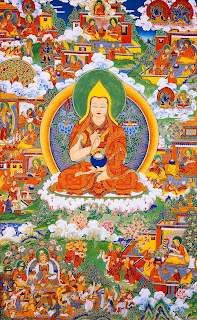 This
thanka is probably painted in Central Tibet.
This
thanka is probably painted in Central Tibet.
A
teacher (guru) of the Ka-dam-pa school, Jetsun Yeshey Gyaltshan is portrayed on
the throne holding alms-bowl in the left hand and displaying vitarkamudra in
the right hand. A khakkara or alarm-staff is placed on his right side. Before
the throne a low table is placed bearing a number of ritual objects like holy
water-vessel, mirror, bell, vajra, skull-cup, etc. At the top, in the centre,
crowned Buddha is seated in bhusparsa mudra flanked by Sariputta and Maudgalayana,
his two disciples. Besides there are also figures of Atisa and Drome who
invited Atisa in Tibet. The other deities at the top row are Avalokitesvara,
8yama Tara and Tsong-kha-pa, the great reformer and founder of the Ge-lug-pa
sect. Just above his head is a small figure of Amitayus holding ambrosia vase.
Around him there are the figures of Indian monks, Sravaka (K. Nyentho Gepo),
Brahmin Srimapati (Bramsi gewari-Teshan), Dharmakirti (Palden choddrag), the
great saint and mahasiddha Mila Repa, two other mahasiddhas and the gurus of
the Ka-dam-pa School. On his right and left sides there are the figures of
White Naha (Gan kar, Kong-po-karpo) holding khadga and pasa trampling an
elephant and Yama with Yami riding a buffalo.
Lobzang
Gyatsho, the fifth Dalai Lama (1617-1682) is here seated on throne holding
lotus and book in the right and left hands respectively. The fifth Dalai Lama
was the author of many books and his biography throws an important light on the
religious and secular life of Tibet: In the upper part of the thanka, at the
right and left corners there are the representations of two deities, Padmapani
Avalokitesvara (Chen-ri-zig) exhibiting lotus and the varadamudra in two hands
and Avalokitesvara in vitarkamudra. The lower part of the thanka portrays the
two kings of Tibet, Nva-tri-Tsempo, the first king of Tibet and
Song-tsen-Gampo, the renowned king who introduced Buddhism in Tibet. The
central figure and other accessory figures bear Tibetan inscription at the
bottom which serve as labels for their identification. In Tibet, the Dalai Lama
is the supreme head in all spiritual and temporal matters. He is also regarded
as the incarnation of Bodhisattva Avalokitesvara.
Miscellaneous
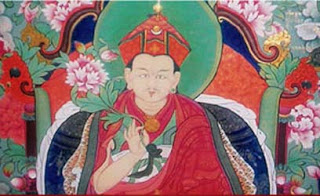 This
thanka represents the refuge tree of the Ge-lug-pa school, representing the
paths of Buddhism. and its propagation in Tibet. The central figure is Buddha Sakyamuni
in blumisparsamudra and around him in all directions are grouped the
Bodhisattvas, saints, propagators and protective deities of the Mahayana
Buddhism. Buddha with an image of Adi Buddha Vajradhara in yab-yum at heart is
flanked by Bodhisattva Maitreya and Manjusri on either side. On top of the
thanka, in the middle, is portrayed the figure of Vajradhara and his Sakti in
yab-yum, mahasiddhas, Bodhisattva Manjusri, Atisa, Tsong-kha-pa and the lineage
of the Ge-lug-pa school. To the right and left of Buddha are grouped the Indian
and Tibetan saints of the Vajrayana Buddhism.
This
thanka represents the refuge tree of the Ge-lug-pa school, representing the
paths of Buddhism. and its propagation in Tibet. The central figure is Buddha Sakyamuni
in blumisparsamudra and around him in all directions are grouped the
Bodhisattvas, saints, propagators and protective deities of the Mahayana
Buddhism. Buddha with an image of Adi Buddha Vajradhara in yab-yum at heart is
flanked by Bodhisattva Maitreya and Manjusri on either side. On top of the
thanka, in the middle, is portrayed the figure of Vajradhara and his Sakti in
yab-yum, mahasiddhas, Bodhisattva Manjusri, Atisa, Tsong-kha-pa and the lineage
of the Ge-lug-pa school. To the right and left of Buddha are grouped the Indian
and Tibetan saints of the Vajrayana Buddhism.
Below
the throne there are in successive rows, the teachers of the Ge-lug-pa school,
Yi-dams or tutelary deities, confession Buddhas, Bodhisattvas and Taras,
deified Lamas with bowl and khakkara, arhats, dakinis and Dharmapalas. The
Lokapalas or four guardian kings of the four directions, east, south, west and
north, namely, Dhritarastra (east), Virudhaka (south), Virupaksa (west) and Vaisravana
(north) are portrayed at the foot of the throne. In front of the throne there
is a symbol of dharmacakra and Brahma and Vishnu, the two deities, are
represented offering wheel and conch-shell. Besides, three of the five great
kings, protectors of monasteries and astrologers are also shown at the bottom
of the thanka.
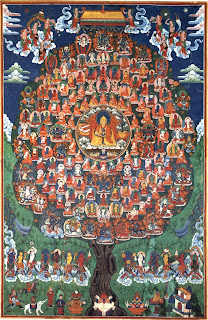 The
thanka probably hails from Central Tibet.
The
thanka probably hails from Central Tibet.
This
is a fortune-telling thanka and as a sort of game, 'the game of Rebirth', it is
played with dice. Unlike other thankas this thanka is interesting for its
subject-matter, which neither depicts a deity nor a monk but a sort of
religious game a popular game of the Tibetan people. Though the subject is
different the ultimate goal of the game as depicted in this painting, like
other thankas is the same, i.e. nirvana or final liberation. Salam Nam Shag
actually describes the path (marga) and the successive stages (bhumi) of
spiritual progress for attaining nirvana. The game was invented by sakyapandita,
the great Sanskrit scholar and guru of the Sakya sect in the early 13th century
A.D. The thanka shows seven horizontal and seven vertical rows representing
seven squares in each row. These squares which symbolically represent the
'board' of the game and cosmic geography illustrate the paths to enlightenment
and final liberation.
At
the top are shown the figures of Amitayus in Sukhavati heaven, Vajradhara in
yab-yum in vajrahumkaramudra and Vajrayogini. In this thanka, devaloka, daityaloka,
manusyaloka, nagaloka, pasuloka and naraka have been illustrated with
representations of deities, arhats, sravakas, asuras, nagas, beasts and the
sufferings in hell. The game is started from the human realm and with the cast
of a dice one proceeds upward or down-ward either to devaloka or to the lower
states of rebirth or naraka. The winner in the game of rebirth reaches the
realm of Buddhahood and nirvana.
 This
thanka represents the refuge tree of the Ge-lug-pa school, representing the
paths of Buddhism. and its propagation in Tibet. The central figure is Buddha Sakyamuni
in blumisparsamudra and around him in all directions are grouped the
Bodhisattvas, saints, propagators and protective deities of the Mahayana
Buddhism. Buddha with an image of Adi Buddha Vajradhara in yab-yum at heart is
flanked by Bodhisattva Maitreya and Manjusri on either side. On top of the
thanka, in the middle, is portrayed the figure of Vajradhara and his Sakti in
yab-yum, mahasiddhas, Bodhisattva Manjusri, Atisa, Tsong-kha-pa and the lineage
of the Ge-lug-pa school. To the right and left of Buddha are grouped the Indian
and Tibetan saints of the Vajrayana Buddhism.
This
thanka represents the refuge tree of the Ge-lug-pa school, representing the
paths of Buddhism. and its propagation in Tibet. The central figure is Buddha Sakyamuni
in blumisparsamudra and around him in all directions are grouped the
Bodhisattvas, saints, propagators and protective deities of the Mahayana
Buddhism. Buddha with an image of Adi Buddha Vajradhara in yab-yum at heart is
flanked by Bodhisattva Maitreya and Manjusri on either side. On top of the
thanka, in the middle, is portrayed the figure of Vajradhara and his Sakti in
yab-yum, mahasiddhas, Bodhisattva Manjusri, Atisa, Tsong-kha-pa and the lineage
of the Ge-lug-pa school. To the right and left of Buddha are grouped the Indian
and Tibetan saints of the Vajrayana Buddhism. 
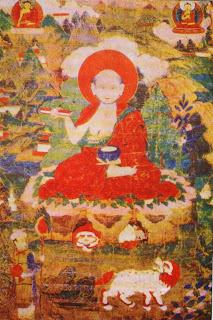
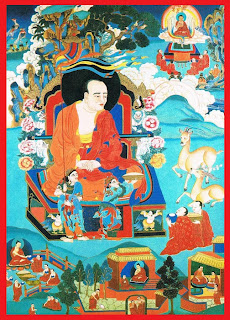












0 Response to "Historical Personages Deified"
Post a Comment